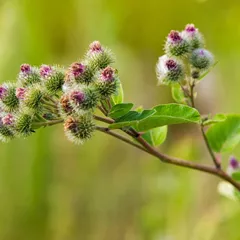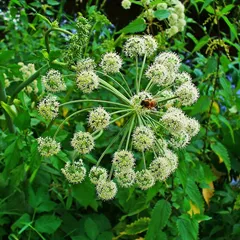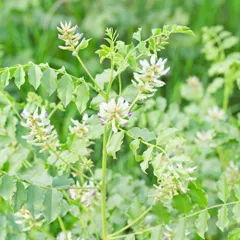Xiao Feng San
Xiao Feng San
Chinese: 消风散
Pinyin: Xiāo Fēng Sàn
Other names: Eliminate Wind Powder from Orthodox Lineage








Xiao Feng San
Xiao Feng San
Chinese: 消风散
Pinyin: Xiāo Fēng Sàn
Other names: Eliminate Wind Powder from Orthodox Lineage
Number of ingredients: 13 herbs
Formula category: Formulas that dredge and disperse External Wind
Conditions for which it may be prescribed: EczemaUrticariaPsoriasis and five other conditions
- Disperses Wind
- Eliminates Dampness
- Clears Heat
- Cools the Blood
Contraindications: Because this formula is primarily dispersing in nature, it should not be used... Because this formula is primarily dispersing in nature, it should not be used in cases with clear Qi or Blood Deficiency. see more
Source date: 1617 AD
Source book: Orthodox Lineage of External M edicine
The information provided here is not a replacement for a doctor. You shouldn't use it for the purpose of self-diagnosing or self-medicating but rather so you can have a more informed discussion with a professional TCM practitioner.
Xiao Feng San is a 13-ingredient Chinese Medicine formula with Japanese Catnip (Jing Jie), Saposhnikovia Roots (Fang Feng), Greater Burdock Fruits (Niu Bang Zi) and Cicada Sloughs (Chan Tui) as principal ingredients.
Invented in 1617 AD, it belongs to the category of formulas that dredge and disperse External Wind. Its main actions are: 1) disperses Wind and 2) eliminates Dampness.
In Chinese Medicine health conditions are thought to arise due to "disharmonies" in the body as a system. These disharmonies are called "patterns" and the very purpose of herbal formulas is to fight them in order to restore the body's harmony.
In this case Xiao Feng San is used by TCM practitioners to fight patterns like Wind-Heat or Damp-Wind. From a Western Medicine standpoint, such patterns can give rise to a range of conditions such as urticaria, eczema or psoriasis for instance.
On this page, after a detailed description of each of the thirteen ingredients in Xiao Feng San, we review the patterns and conditions that Xiao Feng San helps treat.
The thirteen ingredients in Xiao Feng San

Jing Jie is a king ingredient in Xiao Feng San. Like the name indicates, it means it has more power than other ingredients in the formula.
1. Japanese Catnip (Jing Jie)
Part used: Aerial portion and flowers, or the spikes only (in which case it is called Jing Jie Sui)
Nature: Neutral
Taste(s): Pungent
In general Jing Jie's main actions are as follows: "Relieves the Exterior and disperses Cold or Heat depending on the other herbs used. Releases the Exterior for measles. Stops bleeding. Abates swellings."
In the context of Xiao Feng San, it is used because it unblock the interstices and pores and disperse external Wind. .

Fang Feng is a king ingredient in Xiao Feng San. Like the name indicates, it means it has more power than other ingredients in the formula.
2. Saposhnikovia Roots (Fang Feng)
In general Fang Feng's main actions are as follows: "Relieves the Exterior and disperses Cold. Relieves Wind-Damp-Cold painful obstruction. Disperses Wind."
In the context of Xiao Feng San, it is used because it unblock the interstices and pores and disperse external Wind.

Niu Bang Zi is a king ingredient in Xiao Feng San. Like the name indicates, it means it has more power than other ingredients in the formula.
3. Greater Burdock Fruits (Niu Bang Zi)
In general Niu Bang Zi's main actions are as follows: "Relieves the Exterior and disperses Heat. Allows the release of toxicity from the surface and clears Heat. Reduces swelling and clears pathogenic Heat. Lubricates the Intestines. Relieves sore throat."
In the context of Xiao Feng San, it is used because it unblock the interstices and pores and disperse external Wind.

Chan Tui is a king ingredient in Xiao Feng San. Like the name indicates, it means it has more power than other ingredients in the formula.
4. Cicada Sloughs (Chan Tui)
Part used: Dry Cicada slough
Nature: Cold
In general Chan Tui's main actions are as follows: "Clears Wind-Heat and benefits the throat. Allows the release of Toxins from the skin and relieves itching. Expels Wind and relieves spasms and convulsions associated with Heat. "
In the context of Xiao Feng San, it is used because it is unblock the interstices and pores and disperse external Wind.

Cang Zhu is a deputy ingredient in Xiao Feng San. This means it helps the king ingredient(s) treat the main pattern or it serves to treat a coexisting pattern.
5. Black Atractylodes Rhizomes (Cang Zhu)
Part used: The dried rhizome
Nature: Warm
Meridian affinity: SpleenStomach
Category: Aromatic herbs that transform Dampness
In general Cang Zhu's main actions are as follows: "Dries Damp and tonifies the Spleen. Relieves the Exterior for invasion of Wind-Cold-Damp. Relieves Wind-Damp painful obstruction. Dries Damp for either Damp-Cold or Damp-Heat when combined with the correct herbs. Clears the eyes and improves sight."
In the context of Xiao Feng San, it is used because it dries Dampness.

Ku Shen is a deputy ingredient in Xiao Feng San. This means it helps the king ingredient(s) treat the main pattern or it serves to treat a coexisting pattern.
6. Sophora Roots (Ku Shen)
Part used: Dried root
Nature: Cold
Taste(s): Bitter
Meridian affinity: BladderHeartLarge intestineLiverStomach
Category: Herbs that clear Heat and dry Dampness
In general Ku Shen's main actions are as follows: "Expels Damp-Heat. Scatters Wind and relieves itching.Promotes urination and expels Heat. Kills parasites. Applied externally for Damp-Heat."
In the context of Xiao Feng San, it is used because it is an effective herbs for itchiness from Damp-Heat. It also kills parasites and resolves toxicity.

Mu Tong is a deputy ingredient in Xiao Feng San. This means it helps the king ingredient(s) treat the main pattern or it serves to treat a coexisting pattern.
7. Akebia Stems (Mu Tong)
Part used: Dried stem
Nature: Cold
Taste(s): Bitter
Meridian affinity: HeartLungSmall intestine
Category: Herbs that drain Dampness
In general Mu Tong's main actions are as follows: "Encourages urination and clears Heat. Clears Heat and inflammation of the Heart. Promotes lactation. Moves and smoothes the flow of Blood. Used for painful obstruction associated with either Dampness, Blood Stagnation, Wind or Heat."
In the context of Xiao Feng San, it is used because it drains Damp-Heat through the urine.

Shi Gao is a deputy ingredient in Xiao Feng San. This means it helps the king ingredient(s) treat the main pattern or it serves to treat a coexisting pattern.
8. Gypsum (Shi Gao)
Part used: The mineral itself
Nature: Cold
Meridian affinity: LungStomach
Category: Herbs that clear Heat and purge Fire and/or clear Summer Heat
Shi Gao clears Fire from the Qi Level. It helps drain the Heat from the Interior and prevents the condition from advancing to a deeper level.

Zhi Mu is a deputy ingredient in Xiao Feng San. This means it helps the king ingredient(s) treat the main pattern or it serves to treat a coexisting pattern.
9. Anemarrhena Rhizomes (Zhi Mu)
Part used: Dried rhizome
Nature: Cold
Meridian affinity: KidneyLungStomach
Category: Herbs that clear Heat and purge Fire and/or clear Summer Heat
Zhi Mu clears Fire from the Qi Level. It helps drain the Heat from the Interior and prevents the condition from advancing to a deeper level.

Di Huang is an assistant ingredient in Xiao Feng San. This means that it either serves to reinforces the effect of other ingredients or it moderates their toxicity.
10. Unprepared Rehmannia (Di Huang)
Part used: Prepared dried root tuber
Nature: Cold
Taste(s): Sweet
Meridian affinity: HeartKidneyLiver
Category: Herbs that cool the Blood
In general Di Huang's main actions are as follows: "Expels Heat by Cooling Blood. Tonifies Yin by promoting Fluid production. Soothes the Heart by calming Blazing Fire. Cools and nourishes."
In the context of Xiao Feng San, it is used because it cools the Blood. All assistant herbs help the Blood as a means of extinguishing the Wind.

Dang Gui is an assistant ingredient in Xiao Feng San. This means that it either serves to reinforces the effect of other ingredients or it moderates their toxicity.
11. Dong Quai (Dang Gui)
Part used: Dried root
Nature: Warm
Meridian affinity: HeartLiverSpleen
Category: Tonic herbs for Blood Deficiency
Dang Gui nourishes and invigorates the Blood. All assistant herbs help the Blood as a means of extinguishing the Wind.

Hei Zhi Ma is an assistant ingredient in Xiao Feng San. This means that it either serves to reinforces the effect of other ingredients or it moderates their toxicity.
12. Black Sesame Seeds (Hei Zhi Ma)
Part used: Dried seeds
Nature: Neutral
Taste(s): Sweet
Meridian affinity: KidneyLiver
Category: Laxative herbs that drain downward
Hei Zhi Ma nourishes the Blood and moistens. All assistant herbs help the Blood as a means of extinguishing the Wind.

Gan Cao is an envoy ingredient in Xiao Feng San. This means that it directs the formula towards certain area of the body and/or harmonizes the actions of other ingredients.
13. Liquorice (Gan Cao)
Part used: Dried root and rhizome
Nature: Neutral
Taste(s): Sweet
Meridian affinity: HeartLungSpleenStomach
Category: Tonic herbs for Qi Deficiency
In general Gan Cao's main actions are as follows: "Tonifies the Basal Qi and nourishes the Spleen Qi. Clears Heat and dispels toxicity. Moistens the Lungsexpel phlegm and stop coughing. Relieves spasms and alleviates pain. Harmonizes and moderates the effects of other herbs."
In the context of Xiao Feng San, it is used because it clears Heat, resolves toxicity, and harmonizes the actions of the other herbs.
Conditions and patterns for which Xiao Feng San may be prescribed
It's important to remember that herbal formulas are meant to treat patterns, not "diseases" as understood in Western Medicine. According to Chinese Medicine patterns, which are disruptions to the body as a system, are the underlying root cause for diseases and conditions.
As such Xiao Feng San is used by TCM practitioners to treat two different patterns which we describe below.
But before we delve into these patterns here is an overview of the Western conditions they're commonly associated with:
Urticaria Eczema Psoriasis Contact dermatitis Schonlein-Henoch purpura Drug rash Tinea infection Diaper rash
Again it wouldn't be correct to say "Xiao Feng San treats urticaria" for instance. Rather, Xiao Feng San is used to treat patterns that are sometimes the root cause behind urticaria.
Now let's look at the two patterns commonly treated with Xiao Feng San.

'Heat' as a body pattern in Chinese Medicine is one of the so-called "Eight Principles". Learn more about Heat pattern in Chinese Medicine
Wind-Heat
Pulse type(s): Rapid (Shu), Floating (Fu)
Symptoms: Fever Chills Thirst Sneezing Coughing Sweating Headaches Runny nose Sore throat Yellow mucus Fear of wind Blocked nose Itchy throat Swollen tonsils Aversion to cold Occipital stiffness Occipital headaches
Xiao Feng San is sometimes prescribed by TCM practitioners to treat Wind-Heat. This pattern leads to symptoms such as aversion to cold, fever, sneezing and coughing. Patients with Wind-Heat typically exhibit rapid (Shu) or floating (Fu) pulses.
Within the Four-Levels theory, Wind-Heat is the first level of invasion of External Pathogens, when it still resides in the body's Exterior.
This pattern is similar to Wind-Cold, but the Wind is together with Heat rather than Cold. The common symptoms are aversion to cold, sneezing, coughing, runny... read more about Wind-Heat

Wind is one of the pathogenic factors in Chinese Medicine. Learn more about Wind in Chinese Medicine
Damp-Wind
Pulse type(s): Slippery (Hua), Floating (Fu)
Symptoms: Fever Nausea Sweating Body aches Muscle ache Swollen joints Aversion to cold Swollen neck glands Occipital stiffness Feeling of heaviness
Xiao Feng San is sometimes prescribed by TCM practitioners to treat Damp-Wind. This pattern leads to symptoms such as aversion to cold, fever, swollen neck glands and nausea. Patients with Damp-Wind typically exhibit slippery (Hua) or floating (Fu) pulses.
This pattern indicates the early stage of Exterior Wind and Dampness invasion. When there is Dampness obstructing the Connecting channels, it gives rise to swollen glands in the neck. When it obstructs the joints, it leads to pain there. It can also cause muscle ache and feeling of heaviness if the... read more about Damp-Wind
Formulas similar to Xiao Feng San
Zhu Ye Cheng Liu Tang is 38% similar to Xiao Feng San
Dang Gui Yin Zi is 38% similar to Xiao Feng San
Long Dan Xie Gan Tang is 31% similar to Xiao Feng San
Shu Jing Huo Xue Tang is 31% similar to Xiao Feng San
Jiu Wei Qiang Huo Tang is 31% similar to Xiao Feng San
Qing Xin Li Ge Tang is 31% similar to Xiao Feng San















